Hoya Lacunosa - home care
An exotic guest from Indonesia and Malaysia, Hoya Lacunosa, has taken root and adapted in European countries. Now it is successfully grown by flower growers from the countries of the former CIS. The plant with decorative leaves and amazing fragrant flowers adorns the living collections of millions of people.
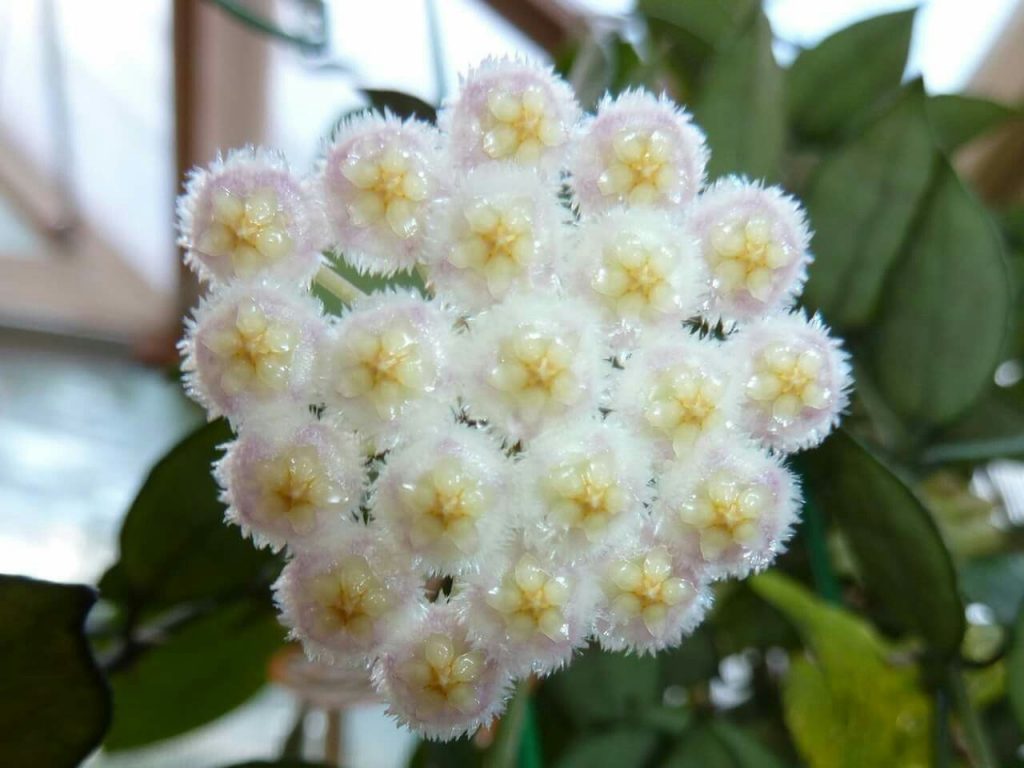
Hoya lacunosa photo
Description of the plant
The botanical name is Hoya lacunosa.
This epiphytic hoya in nature lives in close connection with the trees around which it twists and ants. It is also called concave because of the unusual shape of the leaves - they are small, diamond-shaped, with a curved core. On the back, the leaves have a glossy sheen. Shoots do not curl, but cascade down. This is a distinctive feature of the Lacunosa species.
The flowers are unusual, white, in shape - fluffy balls with a creamy star in the center. Collected in inflorescences of 20 pieces, drops of nectar on the surface do not stand out. The aroma is pleasant, sweetish, reminiscent of an expensive perfume, intensifies at night. Hoya blooms from May to August. Sometimes it can release flower stalks in early spring - in March.
Varieties
The Lacunosa species has several artificially bred varieties. Each of them has features of growth, flowering and content. For the successful cultivation of a flower, it is necessary to decide on its variety so as not to be mistaken in creating favorable conditions for it.
Eskimo
The variety is interesting in the shape of the leaves - they are small and look like hearts. True, they acquire this appearance only in bright light. In partial shade, they stretch out and lose their decorative effect. There are two varieties - simply Eskimo and Eskimo Silver. The latter is distinguished by a silvery bloom on the leaves, the so-called "splash".
It blooms with white graceful buds with a pleasant hyacinth aroma. The variety got the name "Eskimo" for the color and shape of the flowers - they are creamy white, fluffy, very reminiscent of the famous ice cream. The aroma intensifies at night. For active flowering, the plant needs a lot of light.
Laos
The leaves are large, dense, with cream-colored specks. In the light, they turn brown, and the specks turn white. Lianas are powerful, do not break under their own weight. No special support required. The variety is distinguished by long flowering. The scent of the buds resembles incense.
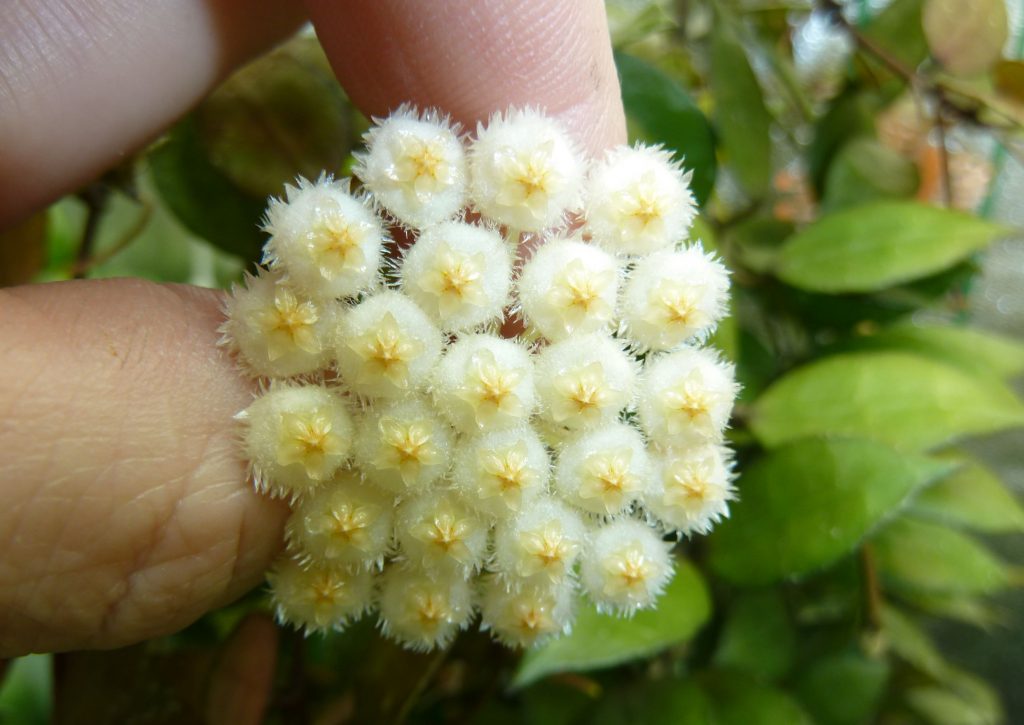
Hoya lacunosa popsicle photo
Heart shape leaf
The shape of the hoya leaves of this variety is heart-shaped, but it becomes so in bright light. In the shade, the leaves begin to stretch, lengthen. Emerald green color is replaced by pale turquoise. The flowers are white with a delicate aroma that intensifies at night.
Bold
The leaves have an interesting pattern of depressed and protruding areas. Lianas do not curl, but hang down in a cascade. Flowers are globular cream with white. Peduncles are elongated, buds are collected in inflorescences of 15-18 pieces.The scent of the flowers is reminiscent of chocolate.
Tove
The variety is distinguished by delicate purple flowers and diamond-shaped leaves up to 6 cm long. In good light, the leaves turn burgundy. Hoya Tove does not tolerate heat, at high temperatures it begins to hurt and is affected by pests.
Langkawi Island
Miniature variety with the smallest leaves of a dark, almost black color. There is a light silvery splash on the surface of the leaf. It blooms with white buds, fluffy, with a creamy star in the middle. Has a pleasant incense smell.
Snow Caps
Castings are elongated, light green, with white splashes. Vines reach 5 meters in length; aerial roots are formed on them in large numbers. Flowers, as is clear from the name of the variety, resemble snow caps. They are fluffy, white, smell nice and strong.
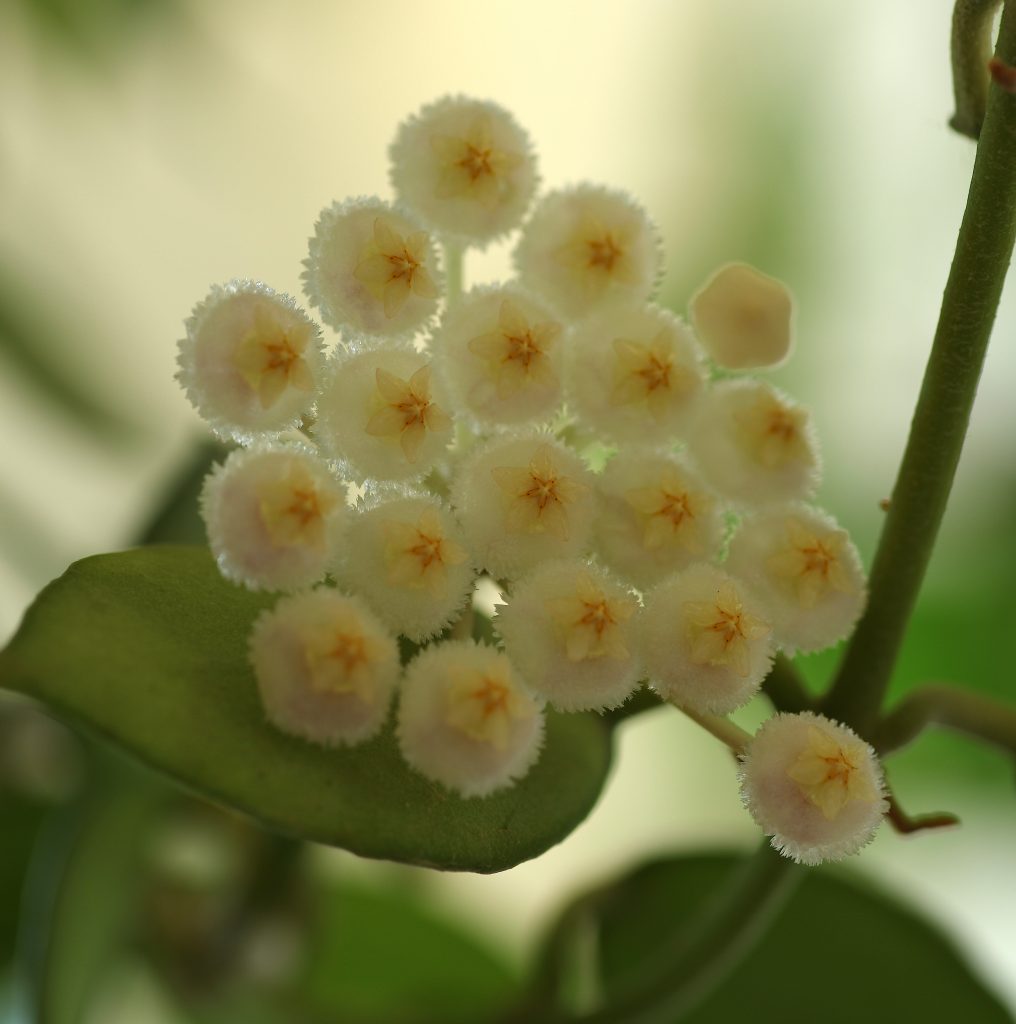
Hoya lacunosa royal flush
Royal Flush
Leaves are capable of changing color depending on the lighting. In partial shade, they are green, monochromatic, without blotches. In the light, the leaf acquires a bronze tint; in good light, silvery specks appear. It blooms rarely and only with an excess of sun. The variety is resistant to diseases, both bacterial and viral.
Purchase and adaptation
Immediately after purchase, the plant needs to be adapted.
Hoya doesn't like moving. Even a simple move from one window to another is stressful for her. After being transported from another country, it is generally incredibly difficult for a flower to get used to a new microclimate and living conditions.
Important! For the first 2-3 weeks, the plant should be kept separate from other indoor flowers. Exotic imported varieties can be contaminated, and local specimens grown from cuttings or seeds do not always shine with health. The hoya must be closely monitored, noticing the slightest changes in her condition.
After two weeks, it is advisable to transplant the wax into a new pot with soil suitable for succulents. The first transfer is carried out regardless of the season. The plant is then placed in a permanent place and no longer moved. It is better to hang the vine in a flowerpot on the wall or on a window where it will have enough light.
Landing rules
Hoya is very light-requiring, so the place for it should be sunny and warm. Southeast or south windows are preferred. You cannot keep hoya on the northern hoyu, but on the western ones you will have to supplement the illumination. Planters with a flower look great right on the window or on the wall by the window. Once you have chosen a place, you no longer need to turn the flowerpot.
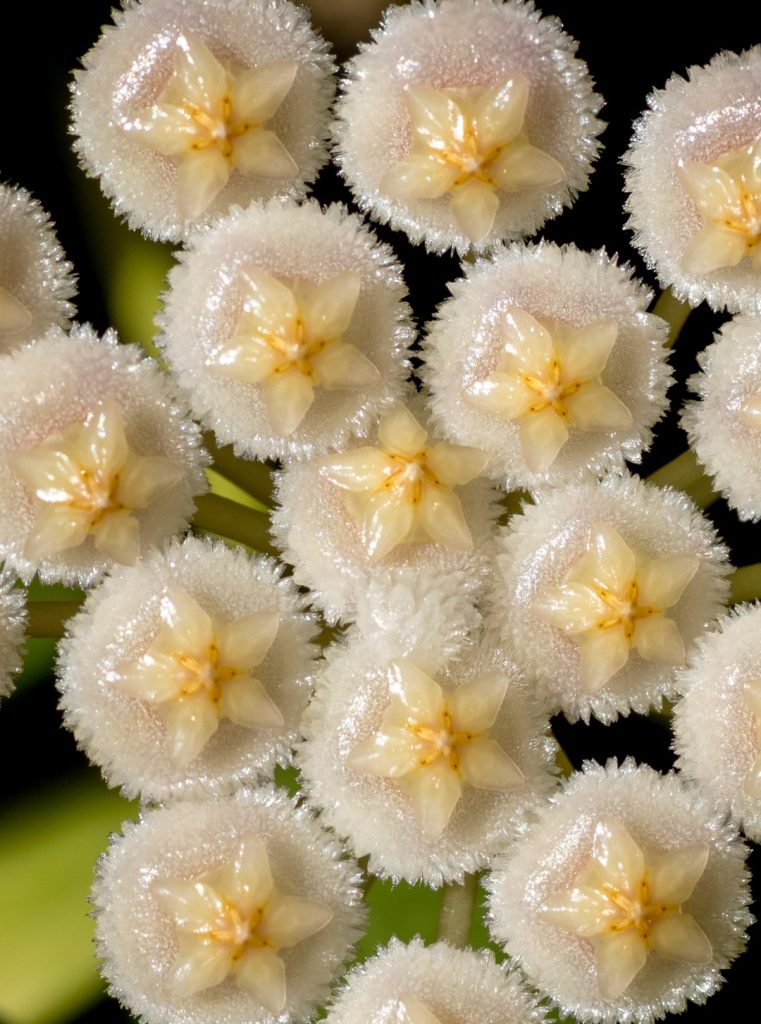
Hoya lacunosa tove
Hoya soil should be as soft and loose as possible. Purchased land is suitable for cacti, but it must be diluted with baking powder. Then it is additionally worth adding a little leaf turf. Hoya is an epiphyte, which means that it needs leaves and humus for nutrition. Further growth and flowering of the plant depends on the correct soil.
The necessary conditions
Hoya Lacunosa is unpretentious, the apartment conditions are perfect for her. However, it is worth considering some of the features of these succulent vines. Ignoring them can even ruin the flower.
Humidity
All succulents are drought tolerant. They don't need high humidity. Even 30-35% is enough for the plant to feel great. Sometimes on hot days, hoya is sprayed with warm water from a spray bottle. Once a year, the plant is even given a "shower" by placing it in the bathtub and pouring it out of the rain. But this must be done when the plant does not bloom.
Temperature
The average temperature of the content is + 22-25 ° С. In winter, a decrease to 16 ° C is possible, although this is not necessary. Wax ivy does not need dormancy as much as other flowering plants. Although flowering after it will always be more lush.
With constant indicators in the region of +22 ° С, hoya can bloom all year round. There will be few inflorescences, but a super pleasant aroma will reign in the house. Lowering temperatures to +15 ° C and below is undesirable for a thermophilic vine. At + 10 ° C, it can die.
Lighting
Hoya needs a lot of light, it should always fall in the same way. The flower does not tolerate permutations. The brightness and even the color of the leaves depends on the degree of illumination. It can vary from pale green to deep burgundy. In bright light, the plant forms more peduncles and blooms longer.
Care
Hoya care rules are simple. This is a resistant plant, which is commonly called "unkillable". However, certain features of care exist and every florist should know them.
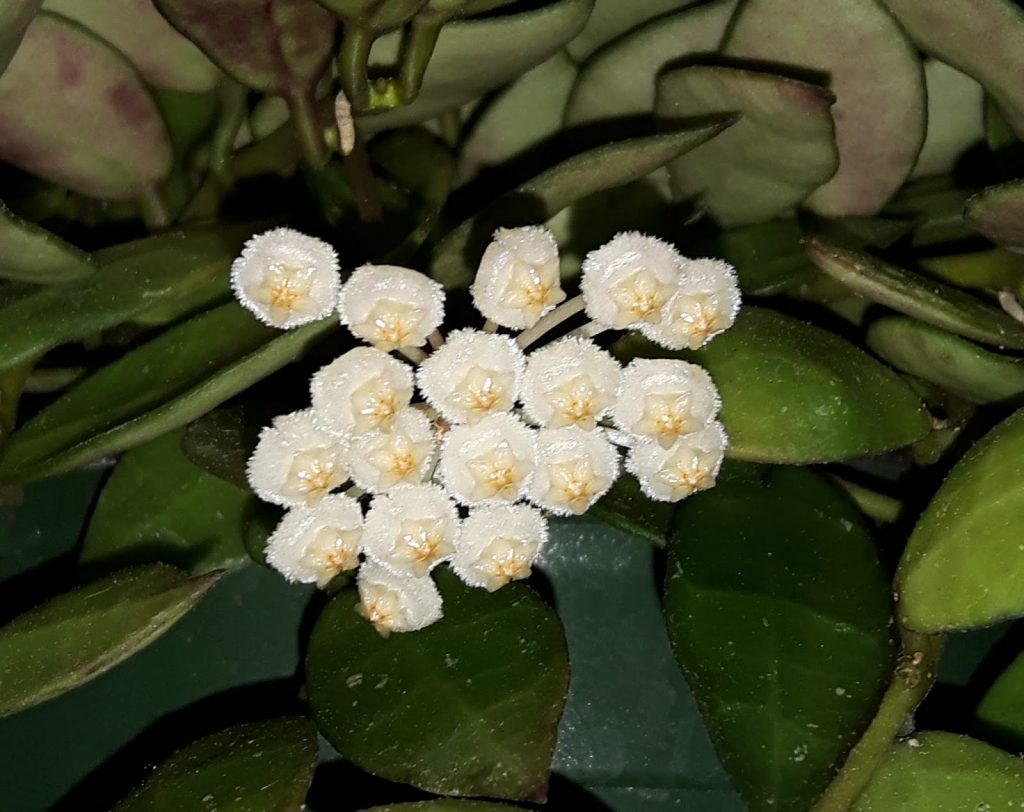
Hoya lacunosa super popsicle
Watering
Thick, fleshy leaves and stems accumulate moisture, the plant can do without water for a long time. But do not test it for strength. In summer, hoya should be watered 2-3 times a week so that the entire earthen lump is moistened.
If the substrate is selected correctly, the flower will be difficult to transfuse. Excess liquid will drain into the drainage holes, the roots will not rot.
Still, do not overdo it with watering. In winter, if the temperature in the room decreases, it can generally be minimized - once a week.
Top dressing
From March to October, the plant is fertilized and fed with mineral complexes. In early spring, it is important for a flower to build up green mass. This requires a lot of nitrogen. Closer to the flowering time, they give more phosphorus and potassium.
Suitable fertilizers:
- Uniflor cactus;
- Florovit;
- Etisso;
- Pocon;
- Agricola for cacti and succulents;
- Good power;
- Stimovit.
Transfer
Often it is not worth replanting the wax wax. Young vines are transferred to new flowerpots once a year, older ones - once every 3-4 years. The most crucial moment is the first transplant after the purchase. The plant is completely removed from the pot, the peat soil is shaken off, the roots are washed off with water.
Drainage is poured into a pre-prepared pot of the same size as the purchased one. Shards, pebbles, pieces of polystyrene are suitable as it. Then the soil for cacti is mixed with baking powder (perlite, vermiculite) and poured into a container. The flower is placed inside, the roots are sprinkled, but not crushed. The plant can be watered a little.
Reproduction methods
Hoya is distinguished by simple and hassle-free reproduction. In many varieties, aerial roots form directly on the vines. This makes it easier to root the cuttings. There are other ways to propagate wax ivy as well.
Seeds
At home, seeds rarely ripen, but they can be found on sale. They are pre-soaked in stimulants, then sown in a light substrate. The container is covered and placed under a conventional incandescent lamp to create a greenhouse effect. The temperature should be within +27 ° С.
The mouths appear on the 10-14th day. From this moment it is necessary to collect condensate and periodically ventilate the "greenhouse". Gradually, the seedlings will become accustomed to the microclimate in the house. After a month, the greenhouse can be removed. They will grow for another 2.5-3 years to the state of an adult plant.
Cuttings
The fastest and most reliable method. Cuttings are cut from vines, you can take segments with aerial roots. Each is dipped in Kornevin, then placed in a substrate. Covering is optional. Rooting occurs in 2-3 weeks.
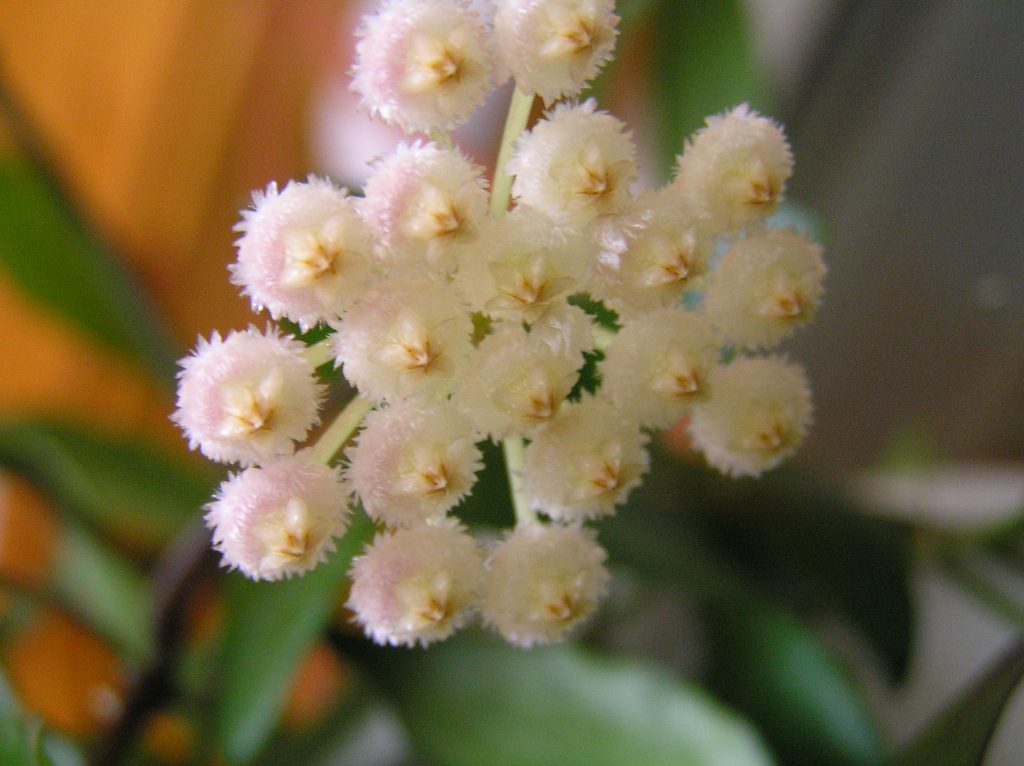
Hoya lacunosa snow caps
To speed up the process, you can raise the temperature and water the plant more often. As soon as the young leaves appear, the plant is considered to have rooted favorably. The next year, a young hoya can bloom.
Sheet
If a leaf is accidentally broken off from a vine, you do not need to throw it away immediately. After holding it in "Kornevin" for a day, it is planted in a very light and loose substrate. If a leaf has at least the rudiments of a petiole, there is a chance to grow a full-fledged seedling. The leaf takes root in 1-2 weeks. The attempt is considered successful if new shoots began to grow next to the leaf.
Diseases and pests
| Problem | Cause | Treatment | Prophylaxis |
| Does not bloom | Lack of light and nutrients | Put in full sun and fertilize well | Do not remove the pot from the light |
| Does not grow | Low nitrogen, poor lighting | Apply nitrogen fertilizer, put in the light | Observe the feeding regime |
| Leaves curl and dry | Coldly | Place the flowerpot in a warm room, place a heater next to it | Avoid a sharp drop in temperature |
| Leaves fall | Dry air | Place the plant under the shower | Spray the leaves |
| Powdery mildew | Low humidity, the room is not ventilated | Tilt, Quadris, Skor, Topaz | Ventilate the room, spray with soapy water |
| Shield | Warm, low humidity, the room is not ventilated | Karbofos, Neoron, Fitoverm | Observe the regime of watering and humidity |
| Spider mite | High room temperature, dry air | Actellic, Anti-tick, Fufanon | Observe the mode of watering and humidity |
Useful videos
Wax ivy will decorate your home collection of plants with its beauty and fragrance of flowers. The plant does not require complex care, and the pleasure of contemplating it can hardly be overestimated. Hoya will delight the owners for many years if they treat her with care.

